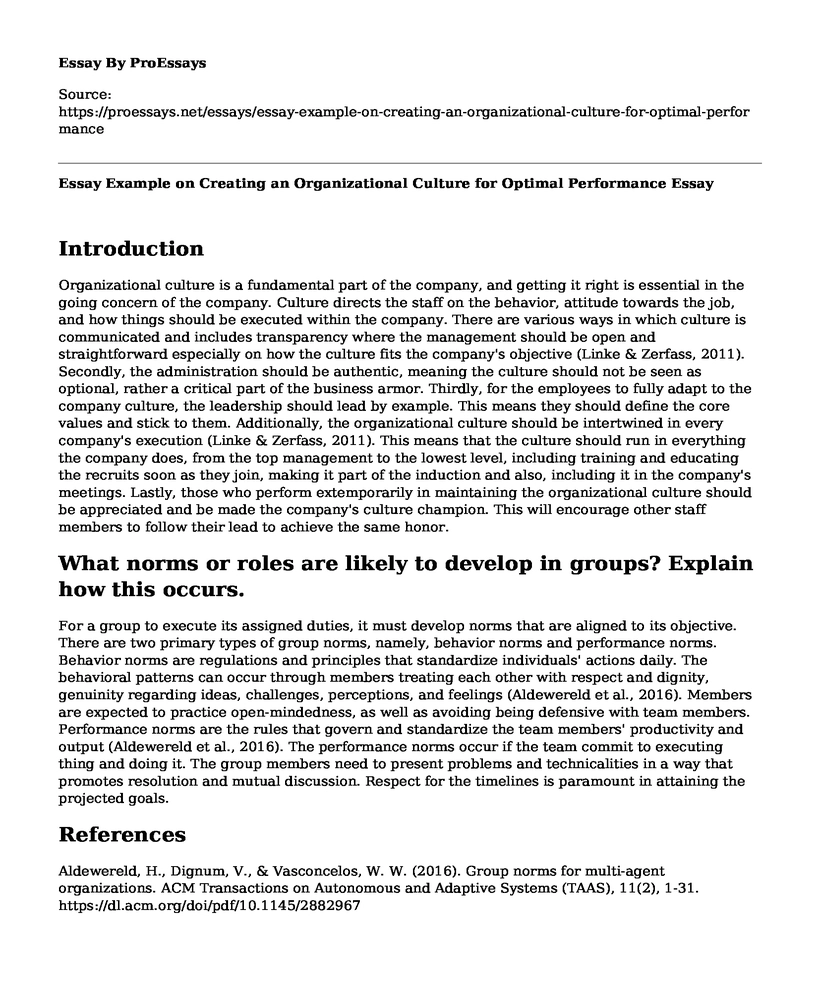Introduction
Organizational culture is a fundamental part of the company, and getting it right is essential in the going concern of the company. Culture directs the staff on the behavior, attitude towards the job, and how things should be executed within the company. There are various ways in which culture is communicated and includes transparency where the management should be open and straightforward especially on how the culture fits the company's objective (Linke & Zerfass, 2011). Secondly, the administration should be authentic, meaning the culture should not be seen as optional, rather a critical part of the business armor. Thirdly, for the employees to fully adapt to the company culture, the leadership should lead by example. This means they should define the core values and stick to them. Additionally, the organizational culture should be intertwined in every company's execution (Linke & Zerfass, 2011). This means that the culture should run in everything the company does, from the top management to the lowest level, including training and educating the recruits soon as they join, making it part of the induction and also, including it in the company's meetings. Lastly, those who perform extemporarily in maintaining the organizational culture should be appreciated and be made the company's culture champion. This will encourage other staff members to follow their lead to achieve the same honor.
What norms or roles are likely to develop in groups? Explain how this occurs.
For a group to execute its assigned duties, it must develop norms that are aligned to its objective. There are two primary types of group norms, namely, behavior norms and performance norms. Behavior norms are regulations and principles that standardize individuals' actions daily. The behavioral patterns can occur through members treating each other with respect and dignity, genuinity regarding ideas, challenges, perceptions, and feelings (Aldewereld et al., 2016). Members are expected to practice open-mindedness, as well as avoiding being defensive with team members. Performance norms are the rules that govern and standardize the team members' productivity and output (Aldewereld et al., 2016). The performance norms occur if the team commit to executing thing and doing it. The group members need to present problems and technicalities in a way that promotes resolution and mutual discussion. Respect for the timelines is paramount in attaining the projected goals.
References
Aldewereld, H., Dignum, V., & Vasconcelos, W. W. (2016). Group norms for multi-agent organizations. ACM Transactions on Autonomous and Adaptive Systems (TAAS), 11(2), 1-31. https://dl.acm.org/doi/pdf/10.1145/2882967
Linke, A., & Zerfass, A. (2011). Internal communication and innovation culture: developing a change framework. Journal of Communication Management. https://www.cin.ufpe.br/~llfj/Emerald/Internal%20communication%20and%20innovation%20culture%20-%20developing%20a%20change%20framework.pdf
Cite this page
Essay Example on Creating an Organizational Culture for Optimal Performance. (2023, May 08). Retrieved from https://proessays.net/essays/essay-example-on-creating-an-organizational-culture-for-optimal-performance
If you are the original author of this essay and no longer wish to have it published on the ProEssays website, please click below to request its removal:
- Research Proposal Example on Toxic Leadership in Organizations
- The Floral Part of the Enterprise, Gibbs Model and Role in a Team Essay
- Paper Example on Perceived Value: Crucial for Sustaining Restaurants in Fierce Competition
- Essay on Harrah's Corp: Loveman's Incentive Plan for Employee Motivation
- Unlocking Project Success: Addressing the Costs of Project Failure - Research Paper
- Essay on Maximizing Impact: Koe Koe Tech Develops Sustainable Goals for Social Entrepreneurship
- Essay Example on Kitchen Essential Products Inc.: Ensuring Safety & Quality Through Duty Of Care







